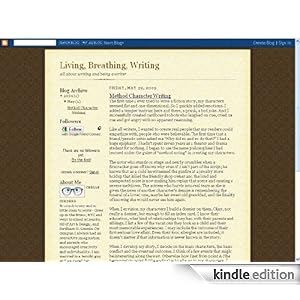Living, Breathing, Writing
[Kindle Edition]
Getting Emotional
Put your reader into the story by making them feel as if they are there. Let them feel emotion. Incite your readers to join you and to experience something through your words. If your reader feels an emotional attachment they will feel as if the words they are reading is reality.
Think of a time, any time, that your community has gone through a defining moment… preferably when you were there. Think of times like severe storms and natural disasters (up to and including hurricanes, tornadoes, floods, earthquakes, etc). If you have been fortunate enough not to have experienced a natural disaster, think of any incident that might have grabbed news headlines locally (i.e.: fires, accidents, lost child). Use any incident that affected you and your emotions. Choose an event that might have changed things whether for the better or worse, so long as the event made an impact on your community or yourself.
Make sure that the reader can identify with you as a real person. Let them know you have feelings, vulnerabilities, hopes and even fears. You’ll find that a reader will often put themselves in the place of a character, or alongside a character, if they believe it is a real person.
Try throwing yourself into the middle of the incident and write about it from your perspective; if you were in the middle of it, describe it from your perspective doing something different than what you did. Write this story in first person. Feel free to make yourself a hero or have the solution to a problem if you would like. Were you frightened, sad, or angry? Don’t say it, show it in your actions. If the power went out and it was dark, mention the shadows, bumping into something or someone, or show how frustrated you were because you couldn’t see the exit or find something you needed without light.
Put feelings into retelling this story, reach deep into your readers’ emotions and let them “feel” as if they are right next to you and the events are happening now. Build tension with your words similar to the way filmmakers use background music building to a crescendo as forewarning of something to come. If the event is a storm you might talk about the increasing volume of the howling winds of the increasingly deafening roar of rain hitting the roof. Don’t add too much unnecessary description or be unnecessarily verbose or you will find that your readers will lose interest or get lost in confusing rhetoric.
One way to get emotional is to make a list of emotions that you felt during the event, or believe you would have felt if you were there or circumstances were different. For each emotion listed write down three things you did based solely on the emotion such as crying, slamming a door, covering your ears so you won’t hear, ducking under a table for protection or anything that was a pure emotional reaction. Make sure that you include these actions in your tale, but try NOT to name the emotion.
Writing Exercise: Practice your point-of-view. Describe the room you are in at this moment and your actions from your point of view (first person: I see, I hear…); then describe the room from the viewpoint of someone standing in the doorway and watching YOU (third person: She sat rocking in the chair…) Remember that in third-person the person describing the room cannot be in YOUR head, they cannot know HOW you feel.
Writing Prompt: Write about your feelings (a.k.a. emotion) for each main color of the rainbow - red, yellow, green, blue and violet. Does any color make you think of a specific memory?
The Living, Breathing, Writing Kindle Blog is available on
|






No comments:
Post a Comment